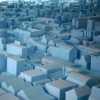Brute Force Architecture
by Bryan Boyer
14 May 2012How Rem Koolhaas’s OMA (Office of Metropolitan Architecture) rewired their office in the late 1990s into a brute force creative machine.
One method stands out: blue foam
New and faster ways to evaluate architectural proposals were needed, namely new means of drawing and model making that shortened the time it required to definitively say yes or no. The answer was blue foam.
OMA is famous for its use of blue foam as a model making material, a technique that uses polystyrene foam cut into desired shapes with a heated wire. Working with foam is a skill that one learns relatively quickly and it allows quick and easy iterations that would be more time consuming to achieve in cardboard. For instance, making a cube from foam can be done with as few as two or three cuts. The same shape out of cardboard would require 24 cuts and the gluing of 6 pieces. Whereas working with cardboard requires planning ahead and some translation of ideas into a workflow of making, with foam the workflow and ideas are collapsed into one. Making is thinking.
One can picture the spark that must have lit up in the eye of a young model maker as their tired fingers parted with a bright yellow Olfa knife and embraced the electrically charged wire of a foam cutter, slicing effortlessly through a block of cool blue foam for the first time.
Working with foam instead of more traditional materials allowed the design teams at OMA to model their ideas quicker, which in turn allowed more ideas to be considered in the same span of time. The adoption of this new technique was akin to upgrading the processor speed of the office.
More so than cardboard or other model making materials, blue foam erases the signature of its creator allowing for an easier ‘apples to apples’ comparison. The anonymizing uniformity of the cut surfaces and alien blueness of the foam itself allowed multiple workers to prepare options in parallel without the differences of personal craft becoming an element of distraction during moments of evaluation. The cumulative effect means that a table covered in foam models all produced by different individuals can be assessed for their ideas rather than the quirks of who made them or how they were created. What’s on display are the ideas themselves, without any distracting metadata or decoration. This is the model making equivalent of Edward Tufte’s quest to eliminate chartjunk.
With extraneous degrees of difference eliminated from the process, the signal to noise ratio of the discussion could be as high as possible.
